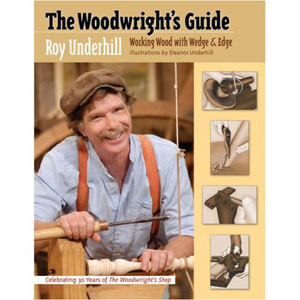
The Woodwright's Guide, by Roy Underhill - Book Review
by J. Norman Reid
Delaplane, VA
It is my privilege to review this most recent book by Roy Underhill, the popularly denoted saint of the woodworking profession. And what a joy to absorb some of the wisdom this master has imparted in this comprehensive and eminently readable volume.
The book's subtitle—"Working Wood with Wedge & Edge"—captures its contents accurately. For these are, in the end, the devices that underlie essentially all hand tools for woodworking, be they used in the forest, at the lathe or in the cabinetmaker's shop. What Roy offers us (Mr. Underhill, may I call you Roy?) is a comprehensive explanation of how to use and maintain essentially every wedge and edge used in woodworking. Strictly hand tools, though; no electric-powered machinery here and, following his wise advice, none needed.
The book begins in the country. First comes felling the tree and the tools and methods for harvesting timber. Then comes cleaving the logs with mallet and wedge before shaping them with adze and firmer chisel, drawknife and spokeshave, among other tools. Following that is a section on drilling and another on chair-making, including weaving seat bottoms from wood strips you've harvested by methods Roy describes.
Roy then describes the tools and methods for building with logs, such as log cabins, and hewed timbers, such as barns. Ever wondered how large timbers are joined and barn walls raised safely? You'll find it here.
These chapters on working raw timber and large beams may be outside the scope of most woodworkers' practices, but it makes for fascinating reading. Learning the names and history of specialized tools is fun and instructive (do you know what a bruzz or preacher do or how the trait de jupiter solves the problem of joining large timbers end-to-end?), even for those of us who will never use them. Even so, there are lessons for those who work on a smaller scale, for some of the problems these methods solve are simply cabinetmaker's problems writ large.
More familiar to most of us, and thus of more immediate practical use, are the final chapters on joinery, turning and cabinetmaking. These chapters are chock full of Roy's accumulated wisdom. Again, his treatment of these subjects is comprehensive and, if brief, nevertheless manages to go straight to the essential. The result is a practical guide to effective hand tool woodworking methods.
The chapter on joinery, for example, covers sawing, workbenches, work holding methods, bench and specialty handplanes, joints of most kinds and making sashes and panels. The chapter on turning discusses mounting the work, rounding, shaping with various chisels, and introduces making screws. The chapter on cabinetmaking distills Roy's knowledge about cutting through (tails first!) and half-blind dovetails, how to cut the secret mitered dovetail joint, making ellipses, rule joints and knuckle joints.
The book is completed with six appendices that present plans for making wooden screws, carpenter's taps, Roubo and Hasluck benches, spring pole and treadle lathes.
This comprehensive treatment of hand tool woodworking, though necessarily succinct, nevertheless includes enough detail to understand and replicate the techniques. The numerous illustrations by Roy's daughter Eleanor Underhill bring the text to full life, amplifying and clarifying otherwise hard-to-grasp points. They are a delight and one of the real highlights of the book.
I came away from my reading with a knowledge of many aspects of woodworking about which I was curious but knew little. This was especially true of the chapters on raw logs and large timbers. The book is delightfully written, with bits of Roy's famous wit scattered throughout.
Overall, I found this to be more than just a fun read. It presents lots of practical advice that will shorten the learning curve for those new to hand tool woodworking and cut down on mistakes by those of us willing to reconsider our working methods. As such, this book has a place on every woodworker's bookshelf, if not indeed in the woodshop itself. I recommend it highly for anyone with an interest in hand tool woodworking.
CLICK HERE to purchase your own copy
of
The Woodwright's Guide
The author is a woodworker, writer, and woodworking instructor living with his wife in the foothills of the Blue Ridge Mountains with a woodshop full of power and hand tools and four cats who believe they are cabinetmaker's assistants.
He can be reached by email at
nreid@fcc.net
.
Return to
Wood News
front page


